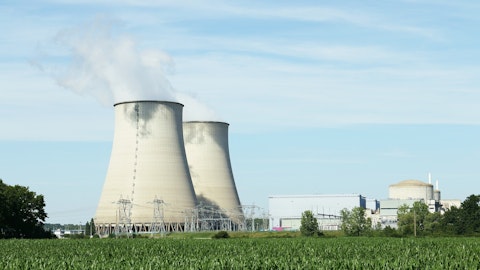Daniel Cregg: Yes. So Jeremy, to your more particular questions. So your first question about cash transacted. By its very nature of what the transaction is, is a liability for future pension payments that will move out of the company and that liability will be matched basically with cash that’s going to go out with it. And so yes, there is a cash element to the transaction. However, you should think about that cash as coming out of the pension trust where those liabilities will be paid from. And so from more general corporate cash, don’t think about any cash from that perspective solely from the trust. That said, and I think that is very a logical way to think about it, given your second question, which is where does that cash come from?
And so we have investments across a bunch of different elements of spectrums of investments that we have made through different managers in the pension trust. And I think just the most natural way to think about it without putting too fine a point on it is, it’s roughly 20% of the pension, and you could think of us as essentially taking about 20% of our investments across the board and moving them over. There’s — that won’t be a perfect interpretation but pretty close to how to think about what it would look like on a go-forward basis from the remaining mix within the funds. So I think that’s a simple way to think about it, but an appropriate way to think about it.
Jeremy Tonet: Got it. That’s very helpful. And then thinking about the pension lift-out here and thinking about kind of 5% to 7% growth CAGR. As previously communicated, is there any impact that we should think about here from this transaction?
Daniel Cregg: No, you should not — I think the 5% to 7% you should think about as being intact. Really, Jeremy, this was all about looking to the potential variability and results that we could see corporately because of the size of the pension. And that was the driver behind the transaction. Ralph made a hugely important point. We’ve said all along, the first thing that we needed to do with our diligence wasn’t sure that this was going to be a move that would protect the benefit to our retirees. We did significant diligence there, I felt very comfortable there. And then secondarily, it needed to ultimately come through in a way that made sense for the company as well. And so that’s exactly what we did. I think that managing that variability going forward is what we have talked about for a while and what we wanted to deliver on.
And you could see some very, very de minimis effects as we step forward within the plan, but nothing that’s going to move us out of that range at all.
Operator: The next question is from the line of David Arcaro with Morgan Stanley.
David Arcaro: Quick follow-up on the lift-out. What does that leave you in terms of a funding ratio post the transfer there?
Daniel Cregg: Yes. So we finished the year at 87% and the year has been pretty good as we work through. So you can kind of think about that as increasing into the low 90s. And so we’re in a good position from a funding perspective with what remains still within that kind of a range as we go forward from here.
David Arcaro: Okay. Got it. Perfect. And then on the Hope Creek fuel cycle extension, is that kicking off earlier here than you had anticipated previously? Or is that still on track toward the potential fall 2025 outage that you had mentioned previously in the Investor Day?




